How To Eat Healthy: A Filipino’s Guide To Go, Grow, Glow Foods
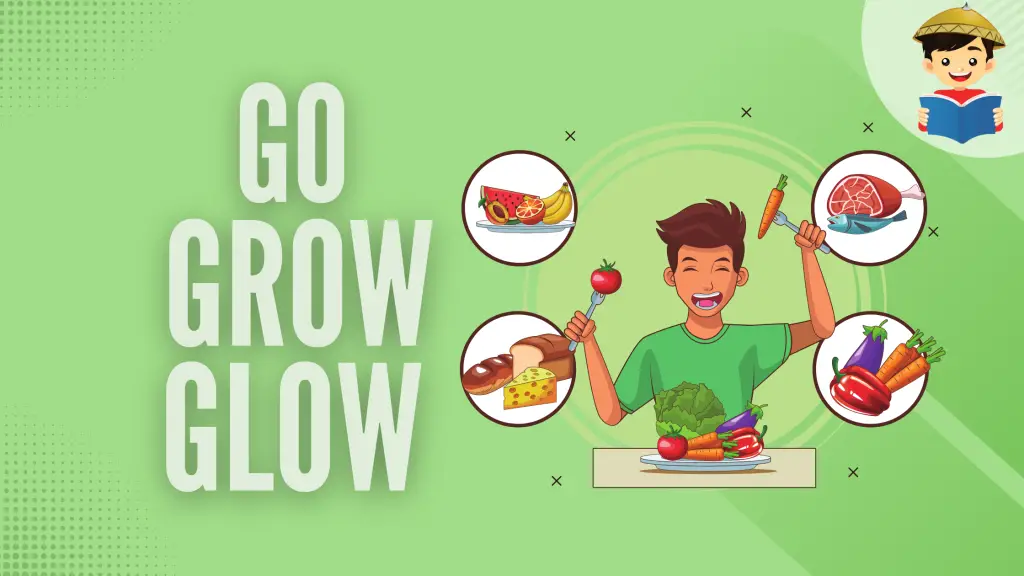
Healthy food does not have to be bland; the right choices can help you feel more energized and inspired.
So, how should you eat to stay healthy? Here’s the first rule: Do not eat more than you need. Portion control is a vital part of healthy eating and essential for weight loss. By eating the right portion sizes, you can also ensure that you get all the vital nutrients.
You can use smaller plates, bowls, and cups so that when your meal is served, it does not look like a mountain of food. This way, you can reduce the amount of food you eat by as much as 20%.
Finally, you will need to jog your memory of the basic food groups, more popularly known as the Go, Grow, and Glow foods!
Table of Contents
- At a Glance: Go, Grow, and Glow Foods
- Go Foods: The Energy-Giving Foods
- Grow Foods: The Body-Building Foods
- Glow Foods: The Body-Regulating Foods
- A Visual Representation of Go, Grow, and Glow Foods
- Frequently Asked Questions
- 1. How much Go, Grow, and Glow foods should I put on my plate?
- 2. Does it matter if I can consume the three food groups in a day but in separate meals?
- 3. I love rice as well as other sources of Go foods. I eat them a lot in a day. Is it healthy?
- 4. What is the Food Pyramid, and how is it different from Pinggang Pinoy?
- References
At a Glance: Go, Grow, and Glow Foods
| Food Group | Major Nutrient/s | Example Sources | Benefits |
| Go | Carbohydrates | – Grains: rice, bread, pasta, cereals – Starchy fruits and vegetables: potatoes, kamote, ube, corn, bananas | – Fuels body with energy – Supplies the brain the nutrients it needs to function properly |
| Grow | Protein | Meat (chicken, pork, beef) seafood, fish, egg, milk, beans, cheese | – Makes bones and teeth stronger – Build and repair muscles and tissues |
| Glow | Vitamins and Minerals | Tomatoes, cabbage, lettuce, papaya, squash, carrots, oranges, watermelon | – Strengthens the immune system to prevent illnesses – Help with hair, nails, and skin |
Go Foods: The Energy-Giving Foods

Go food is the name given to a specific category of calorie-dense foods. In other words, Go foods are those foods that provide the body with its energy needs so it can function properly. Go food refers to carbohydrate sources like starchy vegetables such as potatoes, corn, and kamote; grains like bread, pasta, and rice; and dietary fiber in most vegetables and fruits.
When you consume a healthy portion of Go food, your cells get the nutrients they need to run all day long. You will benefit from eating high-quality carbs like whole grains because they are digested slowly and provide sustained energy for several hours!
It is important to consume enough carbohydrates so that your brain has plenty of glucose to use daily. Your brain consumes 20% of your body’s energy and more than 60% of this is glucose. This means that if you are running low on glucose after a long period without food or during exercise, chemical messengers in the brain will not be produced, and communication between neurons is disrupted. This often results in mental illnesses or brain damage.
Fiber, usually found in Go foods, is another nutrient that plays an essential role in keeping bacteria in your digestive tract healthy by protecting them from harmful substances; it also helps move food through your intestines and prevent constipation.
Suppose you do not eat enough Go foods and are a very active athlete who needs more energy than usual. In that case, your body will break down muscle tissue to create more glucose, resulting in weakness, fatigue, dizziness, and headaches. You may also:
- lose water weight
- feel foggy as your body tries to keep up normal blood sugar levels
- suffer from constipation due to a lack of fiber
- experience an unstable mind due to anxiety and depression
Grow Foods: The Body-Building Foods
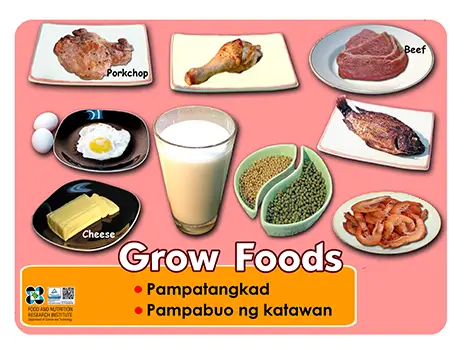
Grow foods are essential as they help the body grow, repair, and heal. They are foods that are rich in protein which serves as the main building blocks of bones, muscles, cartilage, and skin. They also help make hormones and antibodies, which are chemical substances that regulate many body functions and aid fight against germs and viruses. Bacteria and viruses would be able to efficiently infect your body if you do not have these antibodies. Furthermore, proteins improve digestion by creating enzymes that aid
in breaking food into molecules for various biological activities.
Grow foods include meat (pork, beef, chicken), seafood and fish, eggs, plant sources (tofu, nuts, beans, legumes), milk, and dairy products (yogurt and cheese). We must get our protein from different sources, not just one or two because various sources have different amino acids and nutrients.
If you do not get enough protein from Grow foods to feed your important organs, your body starts borrowing protein from the skeletal muscle tissue. And as your skeletal muscle tissues become leaner and weaker, your bones also become more vulnerable to fractures.
Glow Foods: The Body-Regulating Foods
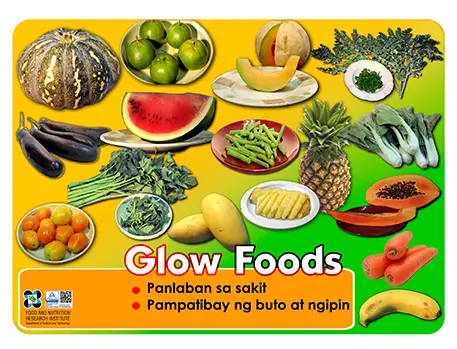
Glow foods are fruits and vegetables that are good for your health. They have vitamins, minerals, and other nutrients that help you feel healthy and strong. Glow foods also help make your skin look beautiful so you can enjoy your glowing complexion!
There are many different types of Glow foods; some help with digestion, and some give us energy for exercise or work, while others reduce stress so we can sleep better at night. Glow foods include red fruits like tomatoes which are red because they contain lycopene; bananas which are rich in potassium; oranges which are full of vitamin C; and green leafy vegetables which are high in iron.
Not eating enough of these Glow foods may lead to digestive problems like constipation, hemorrhoids, and diverticulosis. Cellulose is found in fruits and vegetables, and it helps raise stool weight, ease passage, and shorten transit time. In addition, vitamin E, vitamin C, and carotenoids found in these foods are antioxidants that protect healthy cells from free radicals, which can cause cancer.
A Visual Representation of Go, Grow, and Glow Foods
Pinggang Pinoy1 is a good representation of how your plate should look. It is an easy-to-understand food plate model of Go, Grow, and Glow foods. Developed in 20142 by the Department of Science and Technology – Food and Nutrition Research Institute (DOST-FNRI) in partnership with the Department of Health and with the help of the World Health Organization, Pinggang Pinoy aims to combat malnutrition and nutrient deficiency among Filipinos.
Pinggang Pinoy serves as a visual tool for Filipinos to stay healthy. It aims for more effective Filipino eating habits as you can now easily visualize how a Filipino food plate should be prepared and served. This plate is divided into sections indicating the proportion of Go, Grow, and Glow foods that should be eaten daily. “Glow” foods, represented by a banana and a malunggay plant, occupy half of the plate. “Grow” foods, represented by tilapia fish, make up about one-sixth of the plate. The remaining portion of the plate is occupied by “Go” foods represented by a cup of rice.
The Pinggang Pinoy is beneficial for Filipinos of any age, including old people and even pregnant and lactating women. DOST-FNRI has specialized versions of Pinggang Pinoy3 with detailed guides for every age group (i.e., kids, teens, adults, old people).
Let’s look at the Pinggang Pinoy designed for normal, healthy adults below!
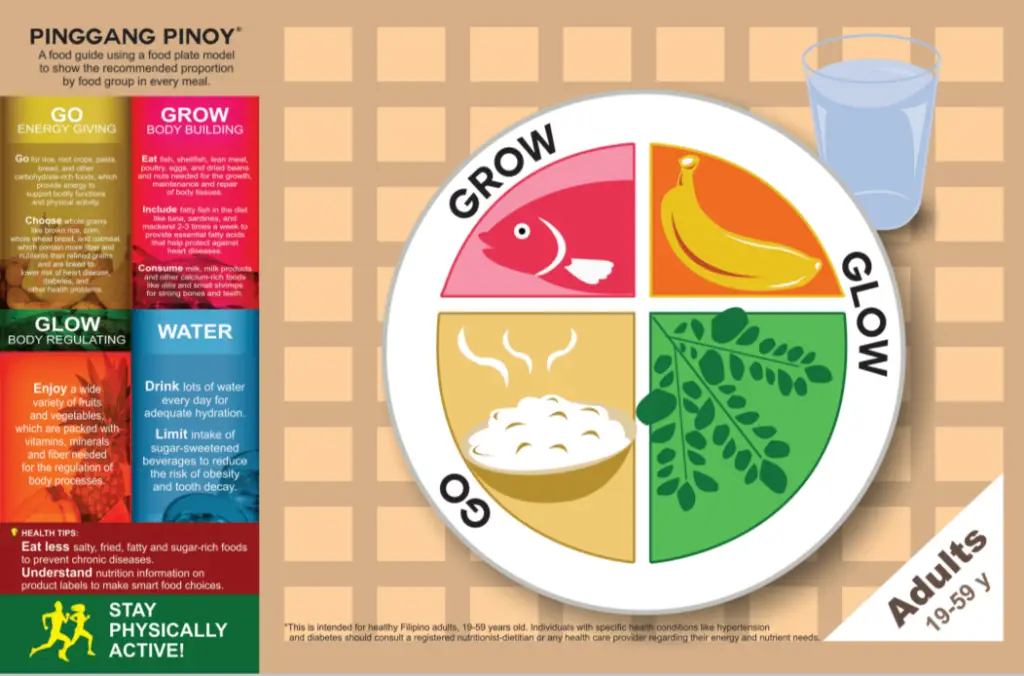
The sample Pinggang Pinoy above is based on an 1890-calorie diet for healthy males and females aged 19 to 59. A one-day sample meal plan is also available to better guide you with the portions of food you should include in your meals.
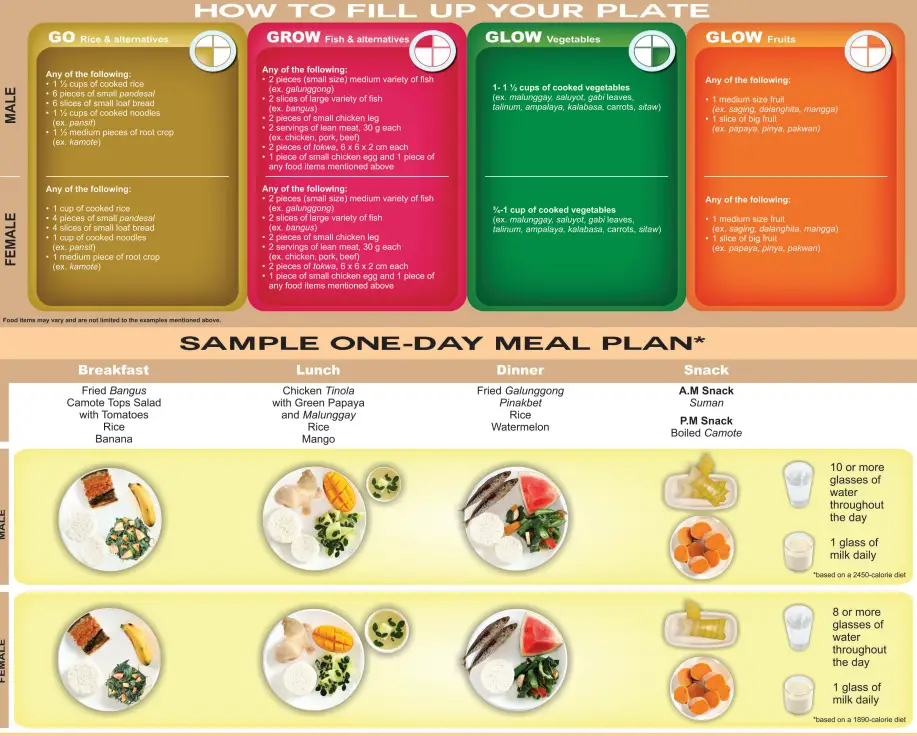
Individuals with specific health concerns should consult with a registered nutritionist dietitian about their energy and dietary requirements. To prevent chronic illnesses, Pinggang Pinoy promotes a physically active lifestyle and urges Filipinos to consume less salty, fried, fatty, and sugar-rich meals.
Here are some helpful tips for using the Pinggang Pinoy:
1. Choose foods with higher fiber and minerals (Go foods)
Brown rice, corn, whole wheat bread, and oatmeal are examples of whole grains. They are higher in fiber and nutrients than refined grains and have been linked to a decreased risk of heart disease, diabetes, and other illnesses.
2. Include fatty fish in your diet and eat calcium-rich meals (Grow foods)
Consume fish, shellfish, lean meat, eggs, dry beans, and nuts for body tissue growth, maintenance, and repair. Include fatty fish like tuna and sardines in your diet 2-3 times per week to get the necessary fatty acids that can help prevent heart disease. For strong bones and teeth, consume milk, milk products, and other calcium-rich foods such as dilis and tiny shrimps.
3. Consume a broad variety of fruits and vegetables (Glow foods)
Fruits and vegetables are great sources of vitamins, minerals, and fiber, which help regulate biological functions.
4. Drink at least eight glasses of water
Remember to drink plenty of water every day to stay hydrated. Sugary drinks should be consumed in moderation to avoid obesity and tooth decay.
5. Keep yourself physically active
Allow your body to sweat. Regular exercise should be at least 30 minutes a day. Walking, jogging, swimming, dancing, and cycling are all exercises that help you burn fat and gain muscle mass.
Frequently Asked Questions
1. How much Go, Grow, and Glow foods should I put on my plate?
DOST-FNRI recommends using the Pinggang Pinoy as a guide for the portions of the basic food groups to consume every day. Pinggang Pinoy for kids, teens, the elderly, and pregnant or breastfeeding women are available on their website4.
2. Does it matter if I can consume the three food groups in a day but in separate meals?
As much as possible, the Go, Grow, Glow foods should be included in every meal. Filipinos should follow the Pinggang Pinoy as a good way to practice moderation, variety, and balance in every meal to get all the nutrients our body needs.
3. I love rice as well as other sources of Go foods. I eat them a lot in a day. Is it healthy?
Eating food items that belong to the same food group in one sitting may lead to nutrient toxicity, nutrient deficiencies, or digestive problems. Pinggang Pinoy and other tools recommended by DOST-FNRI, such as the food pyramid, may help you achieve healthier eating habits.
4. What is the Food Pyramid, and how is it different from Pinggang Pinoy?
The Food Pyramid5 is an easy-to-understand guide to help you make food choices that promote good health. The pyramid illustrates the types and amounts of foods you should eat each day for healthy eating. It represents the types of food you should eat more and food you should eat in moderation or small quantities. The pyramid has six levels, each of which represents a different nutrient.
- Level 1: Bread, cereal grains, rice, pasta, and related starchy foods
- Level 2: Vegetables
- Level 3: Fruits
- Level 4: Milk, yogurt, cheese (and related dairy products)
- Level 5: Meat/poultry/fish/eggs (5 oz serving per week)
- Level 6: Fats and oils
Pinggang Pinoy and the Food Pyramid have similar concepts. They are both designed to promote a balanced, healthy diet that meets nutritional needs by emphasizing foods from each food group on their respective charts.
However, whereas the Pinggang Pinoy serves as a guide per meal, the Food Pyramid
guides Filipinos on the portions of the food group for consumption throughout the day.
It is important to remember that these resources are guides; diets should always be individualized based on one’s personal preferences and medical history.
References
- Food and Nutrition Research Institute – DOST. Pinggang Pinoy [Ebook]. Retrieved from https://www.fnri.dost.gov.ph/images/sources/PinggangPinoy-Adult.pdf
- BusinessMirror. (2022, July 26). Nutritious meals through Pinggang pinoy. Retrieved October 5, 2022, from https://businessmirror.com.ph/2022/07/26/nutritious-meals-through-pinggang-pinoy/
- Gumaru, M. (n.d.). Pinggang Pinoy. Retrieved October 5, 2022, from https://www.fnri.dost.gov.ph/index.php/tools-and-standard/pinggang-pinoy/94-pinggang-pinoy/190-pinggang-pinoy
- Pinggang Pinoy. (2016). Retrieved 18 May 2022, from https://www.fnri.dost.gov.ph/index.php/tools-and-standard/pinggang-pinoy
- Gumaru, M. Daily Nutritional Guide Pyramid. Retrieved 18 May 2022, from https://www.fnri.dost.gov.ph/index.php/tools-and-standard/nutritional-guide-pyramid
Bermonica Satuito, RND
Bermonica Satuito is a Registered Nutritionist-Dietitian (RND) who earned her degree from the University of the Philippines (UP) Los Baños. She is currently practicing in the medical aesthetics industry after working in research at WHO (World Health Organization) Philippines. Qualified and trained in educating individuals to achieve optimum well-being, she writes and creates content about health on various platforms. Youth leadership, community volunteering, SDGs, ASEAN, and entrepreneurship are among her interests.
Copyright Notice
All materials contained on this site are protected by the Republic of the Philippines copyright law and may not be reproduced, distributed, transmitted, displayed, published, or broadcast without the prior written permission of filipiknow.net or in the case of third party materials, the owner of that content. You may not alter or remove any trademark, copyright, or other notice from copies of the content. Be warned that we have already reported and helped terminate several websites and YouTube channels for blatantly stealing our content. If you wish to use filipiknow.net content for commercial purposes, such as for content syndication, etc., please contact us at legal(at)filipiknow(dot)net